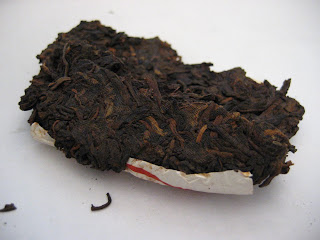
The leaf looks good for a shu, specially when compared to the last two. The color of the first infusion is a nice, clear, deep-red. I should note that the added leaf was left in small chunks, so unfurling will occur over the steeps, however, I did rinse twice.
The aroma from the cup carries a bit of graham and some odor resembling dough. The taste is quite mellow (a term I may have to stop using when talking about shu). Instigated on the tongue is a pleasant taste of sweet dough, bordered by overly-wet mulch. Very warming. Starting on the tongue, then moving through the mouth, the warmth follows the tea down the throat and heats the extremities from the inside.

The wet leaf smells only of one thing: pungent wet wood. Similar to the pungency of freshly cut wood, as if a wood that has been soaked and decomposing has simply refused to give up its pungent odor. An interesting aroma, but one that is not carried into the brewed infusion.
In the 2nd steep, the color of the liquor turns to a deeper red. Permeating in the aroma is a slight maltiness that goes along well with the dough. When the tea is significantly hot, one can taste a hint of the wood aroma that was found on the wet leaf. While finishing off the second steep, I find it interesting, and vexing that I have found another enjoyable shu. Two in a row is an extreme record for me. This one does have value over the menghai brick from yesterday in that the taste is of higher quality and purity. The better looks and texture of the leaves also play their role in this teas status.
The 3rd steep got 10 seconds or so and delivered a soup that was near-brown in appearance. This one becomes a rounded, sweet blend of flavors, with a deep, hard-to-notice huigan. 4th infusion's aroma has the same hint of malt. The flavor provides a nice balance without being overly thick. The warming sensation persists and courses nicely through the body. Huigan builds slightly over the steeps.

Unfortunately, my excitation about finding another good shu all but fades to dust as I notice the flavors in the shu have all blended together by the 4th infusion, maybe even the third.
Retrospect
This shu does rate above yesterdays menghai brick in the aspects of quality and purity. However, I prefer the "crisper" flavors of the menghai brick. This Liming shu tends to blend it's flavors too early, perhaps in the 3rd infusion (post-2 rinses). This becomes an issue in the 4th infusion where it's hard to pick out any flavors from the tea past a simple "pure" feeling. As an end note, this shu is about four times more expensive than yesterdays menghai brick. Obviously not priced according to my tastes.
0 comments:
Post a Comment